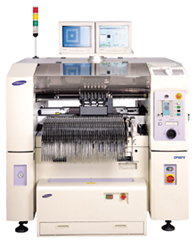SMD Manufacturing

How is it possible this product can be made for such a low price ? There are a number of factors that play a major role. One of them is efficiency and a high level of production automation. Everything a machine can do saves human labour. The application of SMT has several major advantages. The components used are small, often even tiny. This allows electronics to fit onto a smaller and cheaper printed circuit board (pcb). Also the enclosure can be smaller and cheaper. However the most important cost saving is caused by automatic assembly with SMD components by a pick and place machine. A pick and place machine works fast (10.000 or more components per hour) and very accurate (better than 0.01 mm precision). Fully automatic, with minimum labour. An enormous cost saving can be achieved through SMT by raising the production level per human working hour. An extra advantage of SMT is that the weight of the components is much less and the leads are much shorter compared to through hole components. So less mass and a shorter “arm of the force” which results in less torque on the leads during vibration. The vibration resistance increases significantly.
What is SMD and SMT anyway ?
SMT stands for “Surface Mount Technology”. SMT is the name of the mounting technique. It uses components with leads that are placed on the pcb instead of through the pcb. When the leads go through the pcb we call it “through hole”.
SMD stands for “Surface Mount Device”. SMD is the name of the component, suited for SMT.
In practice everybody talks about SMD, being the technique or the component.
SMT production steps
Click on a link below to see a video presentation about SMD manufacturing:
- video of smd manufacturing (screen format 856×480, 8,8 MB)
- video of smd manufacturing (screen format: 428×240, 3,8 MB)
- video of smd manufacturing (screen format: 216×120, 605 kB)
Screening
Solder paste is applied on the contact pads using screen printing.
SMD mounting
The pick and place machine picks up components from various feeders and places them on the correct position on the pcb. The leads are pressed slightly in the solder paste. As the solder paste is a bit sticky, the components stay in position while the other components are placed.
SMD mounting by hand
Some components can’t be handled by the pick and place machine. Those are placed manually.
Reflow soldering
The pcb is passed through an oven so the solder paste melts and actually solders the components to the pcb.
Inspection
The soldered pcb’s are optically inspected for correct mounting and soldering. After that the pcb is ready for the nest step: through hole mounting.
Testing
As a step in between, the pcb can be electrically tested. Any irregularities can be corrected before the through hole components are mounted. Almost all of our products contain an absolute minimum of through hole components. So the pcb is tested once when the pcb is completely assembled.